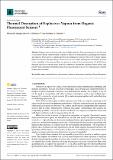Thermal desorption of explosives vapour from organic fluorescent sensors
Abstract
Organic semiconductors can be used as highly sensitive fluorescent sensors for the detection of trace-level vapours of nitroaromatic explosives. This involves fluorescence quenching of the sensors and indicates the presence of explosives in the surrounding environment. However, for many organic fluorescent sensors, the quenching of fluorescence is irreversible and imposes a limitation in terms of the reusability of the sensors. Here, we present a study of thermal desorption of 2,4-DNT from thin-film explosives sensors made from the commercial fluorescent polymers Super Yellow and poly(9-vinyl carbazole). Thermal cycling of the sensor results in recovery of fluorescence, thereby making them reusable.
Citation
Ogugu , E B , Gillanders , R N & Turnbull , G 2021 , ' Thermal desorption of explosives vapour from organic fluorescent sensors ' , Chemistry Proceedings , vol. 5 , no. 1 , 11 . https://doi.org/10.3390/CSAC2021-10559
Publication
Chemistry Proceedings
Status
Peer reviewed
ISSN
2673-4583Type
Journal article
Description
Funding: This research was funded by the Commonwealth Scholarships Commision, and the NATO Science for Peace & Security Programme under grant agreement MYP G5355.Collections
Items in the St Andrews Research Repository are protected by copyright, with all rights reserved, unless otherwise indicated.

